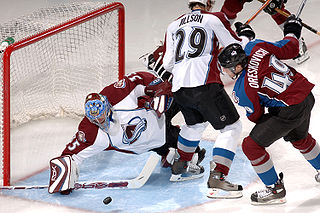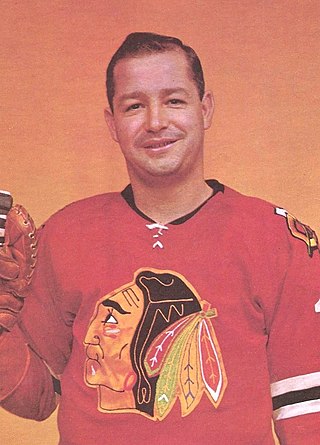
In ice hockey, a goal is scored when the puck entirely crosses the goal line between the two goal posts and below the goal crossbar. A goal awards one point to the team attacking the goal scored upon, regardless of which team the player who actually deflected the puck into the goal belongs to. Typically, a player on the team attempting to score shoots the puck with their stick towards the goal net opening, and a player on the opposing team called a goaltender tries to block the shot to prevent a goal from being scored against their team.

In ice hockey, the goaltender is the player responsible for preventing the hockey puck from entering their team's net, thus preventing the opposing team from scoring. The goaltender mostly plays in or near the area in front of the net called the goal crease. Goaltenders tend to stay at or beyond the top of the crease to cut down on the angle of shots. In the modern age of goaltending there are two common styles, butterfly and hybrid. Because of the power of shots, the goaltender wears special equipment to protect the body from direct impact.

A penalty in ice hockey is a punishment for an infringement of the rules. Most penalties are enforced by sending the offending player to a penalty box for a set number of minutes. During the penalty the player may not participate in play. Penalties are called and enforced by the referee, or in some cases, the linesman. The offending team may not replace the player on the ice, leaving them short-handed as opposed to full strength. When the opposing team is said to be on a power play, they will have one more player on the ice than the short-handed team. The short-handed team is said to be "on the penalty kill" until the penalty expires and the penalized player returns to play. While standards vary somewhat between leagues, most leagues recognize several common varieties of penalties, as well as common infractions.
In ice hockey, a penalty shot is a type of penalty awarded when a team loses a clear scoring opportunity on a breakaway because of a foul committed by an opposing player. A player from the non-offending team is given an attempt to score a goal without opposition from any defending players except the goaltender. This is the same type of shot used in a shootout to decide games in some leagues.

A shot in ice hockey is an attempt by a player to score a goal by striking or snapping the puck with their stick in the direction of the net.

Glenn Henry Hall is a Canadian former professional ice hockey goaltender. During his National Hockey League career with the Detroit Red Wings, Chicago Black Hawks, and St. Louis Blues, Hall seldom missed a game and was a consistent performer, winning the Vezina Trophy, which at the time was awarded to the goaltender on the team allowing the fewest goals against, three times, being voted the First team All-Star goaltender a record seven times, and winning the Calder Memorial Trophy as best rookie. Nicknamed "Mr. Goalie", he was the first goaltender to develop and make effective use of the butterfly style of goalkeeping. In 2017 Hall was named one of the 100 Greatest NHL Players in history. He is the grandfather of Grant Stevenson.

Goals against average (GAA) also known as "average goals against" or "AGA" is a statistic used in field hockey, ice hockey, lacrosse, soccer, and water polo that is the mean of goals allowed per game by a goaltender or goalkeeper. GAA is analogous to a baseball pitcher's earned run average (ERA). In Japanese, the same translation (防御率) is used for both GAA and ERA, because of this.
Ronald Frederick Bradley Tugnutt is a Canadian former professional ice hockey goaltender. Tugnutt played several seasons in the National Hockey League (NHL) with the Quebec Nordiques, Edmonton Oilers, Mighty Ducks of Anaheim, Montreal Canadiens, Ottawa Senators, Pittsburgh Penguins, Columbus Blue Jackets, and Dallas Stars. While a member of the Nordiques on March 21, 1991, Tugnutt set a modern-day NHL record for most saves in a regular-season game when he stopped 70 of 73 shots in a 3–3 tie with the Boston Bruins.
The following are statistics commonly tracked in ice hockey.

Henrik Lundqvist is a Swedish former professional ice hockey goaltender. He played his entire 15-season career with the New York Rangers of the National Hockey League (NHL). Before winning the Vezina Trophy in 2012, he was nominated in each of his first three seasons, and is the only goaltender in NHL history to record eleven 30-win seasons in his first twelve seasons. He holds the record for most wins by a European-born goaltender in the NHL. His dominating play during his rookie season resulted in the New York media and Rangers fans giving him the nickname "King Henrik". During the 2006 Winter Olympics in Turin, Italy, he led the Swedish men's team to their second Olympic gold medal.

Carey Price is a Canadian professional ice hockey goaltender currently under contract for the Montreal Canadiens of the National Hockey League (NHL). Considered one of the best goaltenders in the world during his career, Price is the winningest goaltender in Canadiens history as of the 2022–23 season, with 361 wins.

In ice hockey, butterfly style is a technique of goaltending distinguished by the goaltender guarding the lower part of the net by dropping to the knees to block attempts to score. The butterfly style derives its name from the resemblance of the spread goal pads and hands to a butterfly's wings. The butterfly style is contrasted with stand-up style, where most shots on a goal are stopped with the goaltender on his feet.
This is a list of common terms used in the sport of ice hockey along with the definitions of these terms.

In ice hockey and association football, a goaltender is credited with a save when they prevent a shot by the opponent from entering the net. A goaltender's efficiency in stopping shots, the save percentage, is calculated as a percentage of shots stopped divided by the total number of shots on goal. If a goaltender makes all the saves within a game it is called a shutout. In association football this is called a clean sheet.

William John Smith is a Canadian former professional ice hockey goaltender. He won four Stanley Cups with the New York Islanders and was the first goalie to be credited with a goal in the NHL. In 2017 Smith was named one of the 100 Greatest NHL Players in history.

The 2014 IIHF World Championship was hosted by Belarus in its capital, Minsk, held from 9 to 25 May 2014. Sixteen national teams were competing in two venues, the Minsk-Arena and Chizhovka-Arena. It was the first time Belarus hosted the tournament. The selection of Belarus to host this competition was the subject of much debate, with some politicians in the European Union and North America calling for the IIHF to move the tournament to another country.
In ice hockey, analytics is the analysis of the characteristics of hockey players and teams through the use of statistics and other tools to gain a greater understanding of the effects of their performance. Three commonly used basic statistics in ice hockey analytics are "Corsi" and "Fenwick", both of which use shot attempts to approximate puck possession, and "PDO", which is often considered a measure of luck. However, new statistics are being created every year, with "RAPM", regularized adjusted plus-minus, and "xG", expected goals, being created very recently in regards to hockey even though they have been around in other sports before. RAPM tries to isolate a players play driving ability based on multiple factors, while xG tries to show how many goals a player should be expected to add to their team independent of shooting and goalie talent.
In association football, expected goals (xG) is a performance metric used to evaluate football team and player performance. It can be used to represent the probability of a scoring opportunity that may result in a goal. It is also used in ice hockey.
The 2019 IIHF World Championship Division III was an international ice hockey tournament run by the International Ice Hockey Federation.

Jeremy Ryan Swayman, nicknamed "Sway", or “Bulldog”, is an American professional ice hockey goaltender for the Boston Bruins of the National Hockey League (NHL). The Bruins selected him in the fourth round, 111th overall, of the 2017 NHL Entry Draft.











